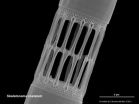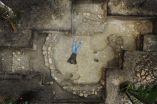INFORMATION:
This research was supported by the National Science Foundation, the Army Research Office, the Georgia Tech School of Biology and the Elizabeth Smithgall Watts Endowment. In addition to Goldman, Mendelson, Astley and Choset, the research team included Miguel Serrano, Patricio Vela and David L. Hu of Georgia Tech, and Chaohui Gong, Jin Dai and Matthew Travers of Carnegie Mellon.
About Carnegie Mellon University
Carnegie Mellon is a private, internationally ranked research university with programs in areas ranging from science, technology and business, to public policy, the humanities and the arts. More than 13,000 students in the university's seven schools and colleges benefit from a small student-to-faculty ratio and an education characterized by its focus on creating and implementing solutions for real problems, interdisciplinary collaboration and innovation. A global university, Carnegie Mellon has campuses in Pittsburgh, Pa., California's Silicon Valley and Qatar, and programs in Africa, Asia, Australia, Europe and Mexico.
Carnegie Mellon's snake robots learn to turn by following the lead of real sidewinders
Research With Georgia Tech, Zoo Atlanta, provides insight into snake motion
2015-03-23
(Press-News.org) Researchers at Carnegie Mellon University who develop snake-like robots have picked up a few tricks from real sidewinder rattlesnakes on how to make rapid and even sharp turns with their undulating, modular device.
Working with colleagues at the Georgia Institute of Technology and Zoo Atlanta, they have analyzed the motions of sidewinders and tested their observations on CMU's snake robots. They showed how the complex motion of a sidewinder can be described in terms of two wave motions - vertical and horizontal body waves - and how changing the phase and amplitude of the waves enables snakes to achieve exceptional maneuverability.
"We've been programming snake robots for years and have figured out how to get these robots to crawl amidst rubble and through or around pipes," said Howie Choset, professor at CMU's Robotics Institute. "By learning from real sidewinders, however, we can make these maneuvers much more efficient and simplify user control. This makes our modular robots much more valuable as tools for urban search-and-rescue tasks, power plant inspections and even archaeological exploration."
Their findings are being published this week in the Proceedings of the National Academy of Sciences Early Edition.
The work is a continuation of a collaboration between Howie Choset, CMU professor of robotics, Daniel Goldman, a Georgia Tech associate professor of physics, and Joseph Mendelson III, director of research at Zoo Atlanta. An earlier study, published on Oct. 10, 2014, in the journal Science, analyzed the ability of sidewinders to quickly climb sandy slopes. It showed that despite the snake's hundreds of body elements and thousands of muscles, the sidewinding motion could be simply modeled as a combination of a vertical and horizontal body wave.
With the model in hand and with a method to measure the movements of living snakes, the team, led by Henry Astley, a postdoctoral researcher in Goldman's group, was able to observe that sidewinders make gradual changes in direction by altering the horizontal wave while keeping the vertical wave constant. They also discovered that making a large phase shift in the vertical wave enabled the snake to make a sharp turn in the opposite direction.
Applying these controls to the robot allowed the robot to replicate the turns of the snake, while also simplifying control.
"By looking for insights in nature, we were able to dramatically improve the control and maneuverability of the robot," Astley said, "while at the same time using the robot as a tool to test the theorized control mechanisms of biological sidewinders."
The modular snake robot used in this study was specifically designed to pass horizontal and vertical waves through its body to move in three-dimensional spaces. The robot is two inches in diameter and 37 inches long; its body consists of 16 joints, each joint arranged perpendicular to the previous one. That allows it to assume a number of configurations and to move using a variety of gaits - some similar to those of a biological snake.
ELSE PRESS RELEASES FROM THIS DATE:
Ascension of marine diatoms linked to vast increase in continental weathering
2015-03-23
Troy, N.Y. - A team of researchers, including Rensselaer professor Morgan Schaller, has used mathematical modeling to show that continental erosion over the last 40 million years has contributed to the success of diatoms, a group of tiny marine algae that plays a key role in the global carbon cycle. The research was published today in the Proceedings of the National Academy of Sciences.
Diatoms consume 70 million tons of carbon from the world's oceans daily, producing organic matter, a portion of which sinks and is buried in deep ocean sediments. Diatoms account for over ...
Archaeologists discover Maya 'melting pot'
2015-03-23
Archaeologists working in Guatemala have unearthed new information about the Maya civilization's transition from a mobile, hunter-gatherer lifestyle to a sedentary way of life.
Led by University of Arizona archaeologists Takeshi Inomata and Daniela Triadan, the team's excavations of the ancient Maya lowlands site of Ceibal suggest that as the society transitioned from a heavy reliance on foraging to farming, mobile communities and settled groups co-existed and may have come together to collaborate on construction projects and participate in public ceremonies.
The findings, ...
Blood test can help identify stroke risk following heart surgery
2015-03-23
WINSTON-SALEM, N.C. - March 23, 2015 - The results of a blood test done immediately after heart surgery can be a meaningful indicator of postoperative stroke risk, a study by researchers at Wake Forest Baptist Medical Center has found.
An acutely elevated level of blood urea nitrogen (BUN) - a measure of kidney function detected through blood testing - was the most powerful predictor of postoperative stroke among the study's subjects.
Up to 9 percent of cardiac surgery patients suffer post-operative stroke, and these events are significantly more serious and more frequently ...
Metformin and vitamin D3 show impressive promise in preventing colorectal cancer
2015-03-23
The concept was simple: If two compounds each individually show promise in preventing colon cancer, surely it's worth trying the two together to see if even greater impact is possible.
In this instance, Case Western Reserve cancer researcher Li Li, MD, PhD, could not have been more prescient.
Not only did the combination of the two improve outcomes in animal studies, but the dual-compound effect was dramatically better than either option alone. Even better, these impressive results required only modest amounts of metformin and Vitamin D3, making concerns about side ...
New gene influences apple or pear shape, risk of future disease
2015-03-23
DURHAM, N.C. - Scientists have known for some time that people who carry a lot of weight around their bellies are more likely to develop diabetes and heart disease than those who have bigger hips and thighs. But what hasn't been clear is why fat accumulates in different places to produce these classic "apple" and "pear" shapes.
Now, researchers have discovered that a gene called Plexin D1 appears to control both where fat is stored and how fat cells are shaped, known factors in health and the risk of future disease.
Acting on a pattern that emerged in an earlier study ...
Experiments reveal key components of the body's machinery for battling deadly tularemia
2015-03-23
(MEMPHIS, Tenn. -- MARCH 23, 2015) Research led by scientists at St. Jude Children's Research Hospital has identified key molecules that trigger the immune system to launch an attack on the bacterium that causes tularemia. The research was published online March 16 in Nature Immunology.
The team, led by Thirumala-Devi Kanneganti, Ph.D., a member of the St. Jude Department of Immunology, found key receptors responsible for sensing DNA in cells infected by the tularemia-causing bacterium, Francisella. Tularemia is a highly infectious disease that kills more than 30 percent ...
Cerebellar ataxia can't be cured, but some cases can be treated
2015-03-23
MAYWOOD, Ill. - No cures are possible for most patients who suffer debilitating movement disorders called cerebellar ataxias.
But in a few of these disorders, patients can be effectively treated with regimens such as prescription drugs, high doses of vitamin E and gluten-free diets, according to a study in the journal Movement Disorders.
"Clinicians must become familiar with these disorders, because maximal therapeutic benefit is only possible when done early. These uncommon conditions represent a unique opportunity to treat incurable and progressive diseases," first ...
Quantum correlation can imply causation
2015-03-23
Contrary to the statistician's slogan, in the quantum world, certain kinds of correlations do imply causation.
Research from the Institute for Quantum Computing (IQC) at the University of Waterloo and the Perimeter Institute for Theoretical Physics shows that in quantum mechanics, certain kinds of observations will let you distinguish whether there is a common cause or a cause-effect relation between two variables. The same is not true in classical physics.
Explaining the observed correlations among a number of variables in terms of underlying causal mechanisms, known ...
Rett Syndrome Research Trust awards $1.3 million for clinical trial
2015-03-23
A surgical sedative may hold the key to reversing the devastating symptoms of a neurodevelopmental disorder found almost exclusively in females. Ketamine, used primarily for operative procedures, has shown such promise in mouse models that Case Western Reserve and Cleveland Clinic researchers soon will launch a two-year clinical trial using low doses of the medication in up to 35 individuals with Rett Syndrome.
The $1.3 million grant from Rett Syndrome Research Trust (RSRT) represents a landmark step in area researchers' efforts to create a true regional collaborative ...
3-D satellite, GPS earthquake maps isolate impacts in real time
2015-03-23
When an earthquake hits, the faster first responders can get to an impacted area, the more likely infrastructure--and lives--can be saved.
New research from the University of Iowa, along with the United States Geological Survey (USGS), shows that GPS and satellite data can be used in a real-time, coordinated effort to fully characterize a fault line within 24 hours of an earthquake, ensuring that aid is delivered faster and more accurately than ever before.
Earth and Environmental Sciences assistant professor William Barnhart used GPS and satellite measurements from ...
LAST 30 PRESS RELEASES:
Making lighter work of calculating fluid and heat flow
Normalizing blood sugar can halve heart attack risk
Lowering blood sugar cuts heart attack risk in people with prediabetes
Study links genetic variants to risk of blinding eye disease in premature infants
Non-opioid ‘pain sponge’ therapy halts cartilage degeneration and relieves chronic pain
AI can pick up cultural values by mimicking how kids learn
China’s ecological redlines offer fast track to 30 x 30 global conservation goal
Invisible indoor threats: emerging household contaminants and their growing risks to human health
Adding antibody treatment to chemo boosts outcomes for children with rare cancer
Germline pathogenic variants among women without a history of breast cancer
Tanning beds triple melanoma risk, potentially causing broad DNA damage
Unique bond identified as key to viral infection speed
Indoor tanning makes youthful skin much older on a genetic level
Mouse model sheds new light on the causes and potential solutions to human GI problems linked to muscular dystrophy
The Journal of Nuclear Medicine ahead-of-print tip sheet: December 12, 2025
Smarter tools for peering into the microscopic world
Applications open for funding to conduct research in the Kinsey Institute archives
Global measure underestimates the severity of food insecurity
Child survivors of critical illness are missing out on timely follow up care
Risk-based vs annual breast cancer screening / the WISDOM randomized clinical trial
University of Toronto launches Electric Vehicle Innovation Ontario to accelerate advanced EV technologies and build Canada’s innovation advantage
Early relapse predicts poor outcomes in aggressive blood cancer
American College of Lifestyle Medicine applauds two CMS models aligned with lifestyle medicine practice and reimbursement
Clinical trial finds cannabis use not a barrier to quitting nicotine vaping
Supplemental nutrition assistance program policies and food insecurity
Switching immune cells to “night mode” could limit damage after a heart attack, study suggests
URI-based Global RIghts Project report spotlights continued troubling trends in worldwide inhumane treatment
Neutrophils are less aggressive at night, explaining why nighttime heart attacks cause less damage than daytime events
Menopausal hormone therapy may not pose breast cancer risk for women with BRCA mutations
Mobile health tool may improve quality of life for adolescent and young adult breast cancer survivors
[Press-News.org] Carnegie Mellon's snake robots learn to turn by following the lead of real sidewindersResearch With Georgia Tech, Zoo Atlanta, provides insight into snake motion



